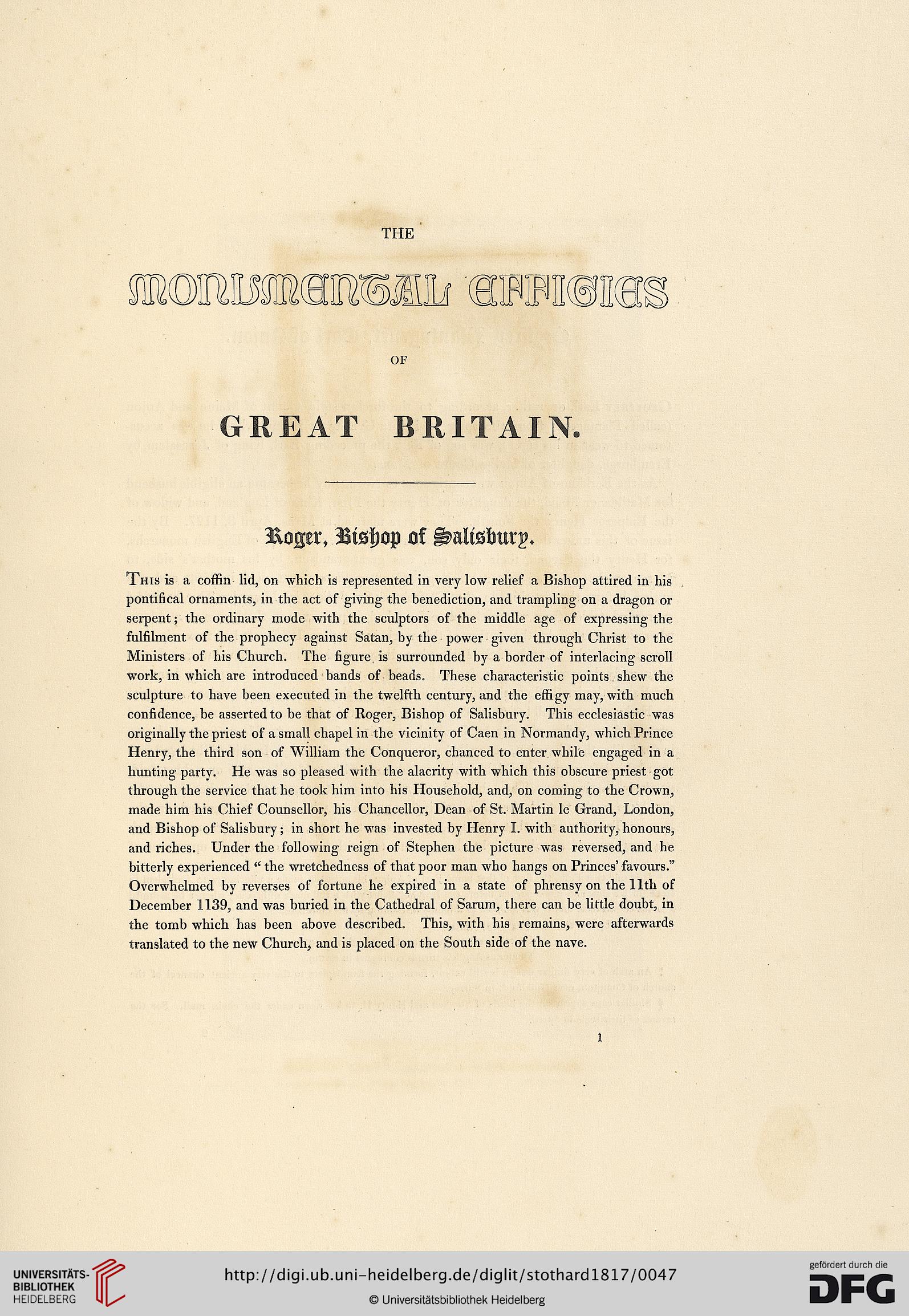THE
GREAT BRITAIN.
%ogor, of ^attgfmrp.
THIS is a coffin lid, on which is represented in very low relief a Bishop attired in his
pontihcal ornaments, in the act of giving the benediction, and trampling on a dragon or
serpent; the ordinary mode with the sculptors of the middle age of expressing the
fulfilment of the prophecy against Satan, by the power given through Christ to the
Ministers of his Church. The figure is surrounded by a border of interlacing scroll
work, in which are introduced bands of beads. These characteristic points shew the
sculpture to have been executed in the twelfth century, and the effigy may, with much
confidence, be asserted to be that of Roger, Bishop of Salisbury. This ecclesiastic was
originally the priest of a small chapel in the vicinity of Caen in Normandy, which Prince
Henry, the third son of William the Conqueror, chanced to enter while engaged in a
hunting party. He was so pleased with the alacrity with which this obscure priest got
through the service that he took him into his Household, and, on coming to the Crown,
made him his Chief Counsellor, his Chancellor, Dean of St. Martin le Grand, London,
and Bishop of Salisbury; in short he was invested by Henry 1. with authority, honours,
and riches. Under the following reign of Stephen the picture was reversed, and he
bitterly experienced " the wretchedness of that poor man who hangs on Princes' favours."
Overwhelmed by reverses of fortune he expired in a state of phrensy on the 11th of
December 1139, and was buried in the Cathedral of Sarum, there can be little doubt, in
the tomb which has been above described. This, with his remains, were afterwards
translated to the new Church, and is placed on the South side of the nave.
1
GREAT BRITAIN.
%ogor, of ^attgfmrp.
THIS is a coffin lid, on which is represented in very low relief a Bishop attired in his
pontihcal ornaments, in the act of giving the benediction, and trampling on a dragon or
serpent; the ordinary mode with the sculptors of the middle age of expressing the
fulfilment of the prophecy against Satan, by the power given through Christ to the
Ministers of his Church. The figure is surrounded by a border of interlacing scroll
work, in which are introduced bands of beads. These characteristic points shew the
sculpture to have been executed in the twelfth century, and the effigy may, with much
confidence, be asserted to be that of Roger, Bishop of Salisbury. This ecclesiastic was
originally the priest of a small chapel in the vicinity of Caen in Normandy, which Prince
Henry, the third son of William the Conqueror, chanced to enter while engaged in a
hunting party. He was so pleased with the alacrity with which this obscure priest got
through the service that he took him into his Household, and, on coming to the Crown,
made him his Chief Counsellor, his Chancellor, Dean of St. Martin le Grand, London,
and Bishop of Salisbury; in short he was invested by Henry 1. with authority, honours,
and riches. Under the following reign of Stephen the picture was reversed, and he
bitterly experienced " the wretchedness of that poor man who hangs on Princes' favours."
Overwhelmed by reverses of fortune he expired in a state of phrensy on the 11th of
December 1139, and was buried in the Cathedral of Sarum, there can be little doubt, in
the tomb which has been above described. This, with his remains, were afterwards
translated to the new Church, and is placed on the South side of the nave.
1




